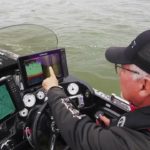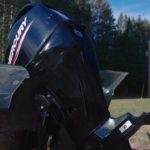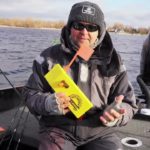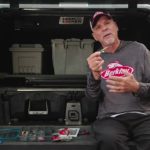Parsons Answers AIM Concerns
An interview with Gary Parsons regarding AIM and it’s plans for 2009
With the recent announcement of AIM’s (Angler Insight Marketing) 2009 Tournament format, there has been a tremendous amount of banter across the walleye world discussing the innovative changes AIM is proposing … some of it supportive, some of it not. I sat down recently with AIM Board member Gary Parsons and asked him to try and answer at least most of the questions regarding the new format and overview AIM’s outlook on the Walleye Tournament future.
Question: Why does it seem AIM has been a bit behind in making announcements to the public regarding its plans for 2009?
 Parsons: The business end of AIM has not really been in place very long. The Board was first elected in June, 2008 and from that point on they had to come up with a very strong business plan and start working on details for 2009. One of the things we did was to survey the manufacturers to see what their needs were in terms of the industry, and that phase was not completed until the end of July-early August. From there we were able to formulate a game plan and begin working on that. So if you look at the reality of what we have been able to put together in five months, it’s been pretty significant. It’s not only been the Pro level tournament circuit we’ve worked on, but also a second phase plan involving a more “grass roots” level that we hope to be able to roll out in the future. It’s been a process that has taken some time.
Parsons: The business end of AIM has not really been in place very long. The Board was first elected in June, 2008 and from that point on they had to come up with a very strong business plan and start working on details for 2009. One of the things we did was to survey the manufacturers to see what their needs were in terms of the industry, and that phase was not completed until the end of July-early August. From there we were able to formulate a game plan and begin working on that. So if you look at the reality of what we have been able to put together in five months, it’s been pretty significant. It’s not only been the Pro level tournament circuit we’ve worked on, but also a second phase plan involving a more “grass roots” level that we hope to be able to roll out in the future. It’s been a process that has taken some time.
Question: By “grass roots” level, are you talking about something geared more to the weekend anglers?
Parsons: Yes. It’s not something we can really discuss yet, but one of our big criticisms has been that we are only looking out for the pros, at the expense of the regular angler in our sport, when in fact the “regular tournament angler” has been a huge part of our overall plan. We are trying very hard to change the sport for the betterment of everyone, with a very forward-looking approach. Not just better for the “Pro” anglers, but everyone interested in tournament walleye fishing at all levels.
If you compare AIM to other tournament organizations out there I’d have to say yes, we are a little behind schedule, but let’s face the facts – we are working in an environment where our country’s economy is in the worst shape it’s been in during our life time. Many of the companies we do business with do not make their final budget decisions until mid-December to Mid-January. Some of the companies may even take longer than that to set their budgets. Part of this is due to the uncertainty in the economy; part of it is because AIM is a new endeavor, and before now has not been considered in these companies budgets.
We never envisioned AIM to be something gigantic right out of the chute. Board members and owners alike knew this would be a process that is going to take time to become fully implemented. The only thing we ask from the walleye fishing public is to have a little patience. We will announce things as they occur. The one thing you will find out from AIM is that we are not afraid to have discussions with the anglers that drive our sport, we are not afraid to listen, and we are not afraid to do things that in our group opinion will change the sport for the better.
Question: AIM recently announced their tournament plans for 2009 including the unique CRR (Catch, Record and Release) format. Much discussion has been taking place in coffee shops, taverns and across the internet wondering just how this format is going to work and if AIM really thought this through before announcing it. How would you address those concerns?
Parsons: Those questions and concerns are viable. These are major changes to what’s been done in the past. CRR was actually suggested to the PWT about two years ago, but never implemented. The ideology came about after a thorough evaluation of what was happening in the industry, in walleye tournaments, and with various states’ fisheries departments. We felt this was a direction that we had to take. Many states have begun to regulate tournaments very heavily. Many of the states in the “Walleye Belt” of Minnesota, Wisconsin, the Dakotas, and Iowa, have all enacted legislation specifically aimed at tournaments. Some of those regulations do not allow us to hold tournaments during the summer, warm-water months. Some allow us to hold events in the summer, but they have to be “kill” events. Some of the legislation is No-Culling, and some of it, as in Minnesota, has been to implement severe slot limits. All these regulations are put in place to try and preserve the fisheries and keep them healthy and viable, which I’m all for, as I think most anglers are, particularly those anglers involved in tournaments. It’s to all anglers’ benefit to care about keeping those fisheries healthy. Unfortunately, all of those same regulations have crippled our ability to have true competitions on many bodies of water. I know there are many anglers, including many of those on AIM’s board, that agree with me when I say, in many cases tournaments run under those conditions are not nearly as much fun to fish as they used to be.
What we wanted to do with our new tournament format was to inject excitement back into the sport, with the ability to have tournaments on great bodies of water during peak times and to have the ability to sample all that a body of water could offer. We needed an alternative format that would allow us to have the best chance to accomplish this goal. That’s why the CRR platform … Catch, Record, Release was decided on. By catching, recording and releasing, we should be able to fish bodies of water in the middle of summer; we don’t have to work within the limit of a slot; we can effectively upgrade our catch throughout the day regardless of no-cull regulations; and we can fish all day everyday – no longer having to end the day at mid-morning because we have our limit and are not allowed to cull. By recording the fish as they are caught and releasing them, we are able to bring back the true competition to the sport, fishing bodies of water known for great walleye fishing, and do so in a fun and exciting type of competition that is good for the sport and the anglers.
Question: Doesn’t CRR then take away some of the strategy involved in fishing a tournament in a slot or no-cull situation?
Parsons: Actually, all it does is set up competition with a whole new type of strategies. Instead of having a strategy on a restricted slot-limit lake where you are regulated to only keep fish in the 16 to 18 inch range with maybe one fish over that limit, this format will allow you to actually go out there and fish for the best walleyes that body of water has to offer. Strategies for catching small fish are most often much different than strategies used to catch larger fish. If anything, this type of format will eliminate much of the “luck” factor where an angler may get lucky and pop a 28 incher as his big fish to go along with his limit of smaller slots. In this format, the guys that can go out there and find and catch the best and biggest fish the system has to offer will be at the top. On some bodies of water, a limit of one-pounders may be the best catch of the day. On others, the winning strategy may be to go for 3 big bites in a day instead of filling a limit with smaller fish. It really just offers up a whole new set of strategies.
Question: What do you say to the guys that claim measuring fish is a bad idea and opens the door to a lot more cheating?
Parsons: Honestly, I don’t see where this opens the door for more cheating than any other format and it is quite frankly one of the main reasons we set it up so that the Co-anglers are not actually competing. To be real truthful, we reduced the entry fee for the Co-anglers so that it’s easier for them to come in and have a great learning experience, and help “monitor” the CRR program. Keith Kavajecz mentioned in a recent interview, that the learning experience these Co-anglers will gain will be as much about the thought processes and decision making that goes on over the course of a day on the water as it is about (if not more so) the tackle and techniques used by the Pros to actually catch the fish. They’ll be able to witness first hand these guys deciding things like when to stick with a particular pattern or when to pull up stakes and try something different. They’ll see how anglers adapt to changing conditions and all those “little” things that go on in a boat during the day that make the difference between a great day of fishing and a mediocre one. Plus it puts all these anglers, pros and co-anglers alike, on great bodies of water during peak times of the season with the ability to fish full days so they’ll have the most fun fishing there is to be had. It offers a lot of advantages and attraction for Co-anglers to sign up. No doubt it will be a huge benefit to each pro to teach his co-angler all he can about how to catch the fish since fish the Co-angler catches count just as much as the ones the Pro catches. Pro and Co-angler will catch the fish together, measure each fish together, record each fish together and release each fish together. It’s a good scenario for a fun day for the Co-angler and a more fair competition for the Pro-angler. There will always be ways to cheat in a tournament, but many of the Pro-anglers rely on tournaments and sponsors to make a living; I don’t know of any of them that would ever risk their career on cheating. That being said, we feel that this format makes it very difficult if not next to impossible to cheat even for those that would want to.
Question: Obviously with the CRR format, digital cameras are going to play a key role. Will these cameras be provided to the anglers, and what happens in the event of a camera malfunction or “overboard” mishap?
Parsons: That’s one of those parts of this whole thing that we are still in the process of working out. We may be providing cameras, and if so will try to provide each boat with a back-up, or we may be making suggestions to Pros what digital cameras to purchase and encourage each to carry back-ups. It’s not unlike other tournament organizations requiring anglers to have their boats equipped with an operational marine-band radio. If at the radio check your radio is not functioning, you don’t go out until it is. But we haven’t made any final decisions on the actual cameras as yet. I know that in my case, no matter which way we go, I will have a back-up camera on board at all times. Bottom line is if you do not have verification in the form of photographic proof of what you have on your log sheet at the end of the day, you are not going to get the weight counted.
Question: have any of you actually gone out and practiced this CRR in real time to see how it is going to work?
Parsons: To a small extent, but we are planning on having a “Practice Run-Through” sometime this Spring prior to our first event to help iron out any kinks. It’s going to be like anything else that’s new … I’m sure there will be things we’ll learn along the way and we’ll handle those as they arise. I’m sure there will be refinements and changes along the way, but in the long run the benefits far out-weigh the down sides.
Question: How do you address those that are out there saying things like AIM is setting things up this way because the Pros don’t really want Co-anglers in the boat and all they really want is their money?
Parsons: I look at that from the standpoint that; if the Co-angler is looking for a tournament format where they can go out and fish for money, then AIM may not be the circuit for them. However, if they’re looking for a great way to learn cutting edge walleye fishing from the best in the business and have a lot of fun doing it, then I encourage them to come check us out. Many of these Co-anglers are actually really great fishermen in their own right, and many really love the competitive side of the game. But the truth is, even when Co-anglers are fishing in a format where they are competing, they are not making any decisions throughout the day and no matter how skilled they might be, it’s more a matter of who they are drawn to fish with during that event that determines whether or not they are competitive in that tournament. Personally I surveyed every Co-angler I fished with last summer and asked them if they could pay lower entry fees but not get prizes, if they’d still enter as Co-anglers in a tournament like this and to-a-man they all sad “Yes”. I know several other pros did the same thing and heard the same results. The $250.00 entry fee the Co-anglers pay is the same fee that Pros that are non-AIM members pay to enter, on top of their (the pro’s) regular entry fee. Some of that money no doubt will be used for operational costs, especially seeing that AIM is in a “start up” business mode. That doesn’t mean that that’s the way it’s going to be forever. I know as far as I’m concerned, as well as several other Board members, we’d like to see a day when the Co-anglers pay nothing to be in our tournaments. Obviously I can’t promise that will ever happen, but it’s something I know AIM would like to see down the road. Bottom line is there are a lot of guys and gals out there that are excited about this format and see the $250.00 fee as a very fair price to pay for the experience.
Question: Are you worried that since your Co-angler isn’t competing that he or she may not fish in a way that will help you in a tournament?
Parsons: Let me tell you something. In all my years of Pro-Am tournaments, really never seen that happen! I have been in the boat many days on a final day with Co-anglers that because of their previous days’ results really had no chance to place and therefore had nothing to really fish for. But fishermen are a proud group, and every one of those anglers fished hard even though they had nothing really to gain. They would try very hard to learn what you had to show them and they would try very hard to do a good job in the boat regardless of the final results. I think it speaks volumes about the type of people that get involved in this sport. I know that there is some concern that even the last 10 Co-anglers that get to the final cut are going to be randomly drawn. As of today, that still is the case, however because of some pretty cool discussions; we have had an alternative possibility presented that may actually be very fair and still preserve the integrity of the Co to oversee the recording process. We are evaluating this and will discuss at our annual meeting with the members. I’m not guaranteeing any changes, but we are listening to help build a better circuit.
Question: In many Pro-Am tournament formats, it has been a practice that the Co-anglers would help out the Pros by giving them money to help defray expenses like for bait and gas. Will that be encouraged in the AIM format?
Parsons: In the past 5 years of fishing the PWT, that has been totally optional. Some guys gave me money, some didn’t. It really never made a difference to me either way. Fact is, I would like to see more young guys get into this sport, and I know that times are tough and that extra money may be tough for some of them to come by. If they’ve been able to scrape up the $250.00 entry fee and their expenses to get to the tournament and cover their lodging and feel strapped to help out with my expenses, that’s fine. I’d rather they kept their money and just come out and have a great time. I’m going to fish the same way and teach that Co-angler as much as I can no matter whether he can help me out with a few bucks for gas or not. I know most of the pros feel the same way … it really isn’t an issue.
Question: It’s been expressed by many non-Pro anglers in these types of Pro-Am events that they resent the term “Amateur”. I’ve noticed in our conversation today and in much of what I’ve read coming out of the AIM office, you using the term Co-angler … is that a conscious effort to be more “politically correct” in an effort to show more respect to the non-Pro anglers?
Parsons: I’d have to say it is. Truth is over the years I have fished with many Co-anglers that were anything but amateurs! I remember a time when I had Chad Schilling from South Dakota in my boat as a Co-angler (During a PWT Super Pro event) and I think that was the same year he won Rookie of the Year as a Pro! There are a lot of really great fishermen that fish as non-Pros, Co-anglers, whatever you want to call them. The term Co-angler I feel gives those anglers the respect they deserve.
Question: Obviously with the CRR format there will be no actual fish brought to the “weigh-in”, and many are wondering how you plan to carry this off and keep spectators involved and excited, not to mention a TV audience, without there actually being fish on stage?
Parsons: That’s the one concern that’s been brought up since we started this thing that I have to smile about. We live in a new world of technology, and I am convinced that with the images of all the fish being caught and the right kind of media presentation, the CRR “weigh-in” will be every bit, if not more exciting to witness than a conventional weigh-in. I envision an angler stepping up on stage as images and potentially short video clips of his day’s catch flashing on a big screen above the stage bigger than life, capturing not only the fish image, but the excitement of the moment too. I think that will be a lot more exciting than carrying up a bag or basket of fish and setting them on a scale, knowing the longer that procedure takes the less chance those fish have of surviving the ordeal. I can see where the CRR concept will be much more exciting. We hope to be able to also include live action clips from the day’s action on the water to project on screen, as well as via the internet during the day of competition and things like that, so I picture a very exciting stage show with the CRR format.
Question: This is obviously a very new concept in tournament fishing. Has there been any interest thus far from potential Co-anglers and Pros to get involved?
Parsons: Since we first announced the new format there have been a lot of questions, which is the main reason we have been trying to get out there doing interviews like this to answer those questions and address the anglers’ concerns. Right after Keith Kavajecz did his interview with Steve Worrall and that interview was posted on the web, the emails and phone calls began pouring into AIM’s main office, so I’d have to say the feedback has been over-whelmingly positive. I hope that in this interview I’ve added more details to some of the questions and concerns anglers have had regarding the AIM format and the CRR concept.
This is a new and radically different format for walleye tournaments and we anticipate there will be more questions that arise. Remember, the owners of AIM are anglers that are so involved with tournaments that they’ve invested either $5,000 or $4,000 of their own money to see this work. They are guys and gals from the FLW, former PWT, and MWC for the most part, but all want to see a better type of competition that is fun, fair, perhaps leading to a new doorway to the future of walleye events. We love our sport, want to see it grow and would like to see it promoted as a true sport that is driven by fair competition. Because of this background, I’d say that we are open to suggestions and concerns and will work hard to make this a big success for all involved. I know I that I’m really excited about the new season… we’ve got some great locations on board, another to be announced soon, and will be finalizing the last tournament in the near future. Again, watch for the announcements, we’ll let everyone know as this saga unfolds!
For More Information on AIM visit http://www.aimfishing.com





